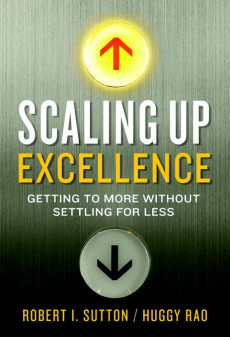
Scaling Up Excellence: Getting to More Without Settling for Less
Robert I. Sutton & Huggy Rao
369 pages, Crown Business, 2014
Robert I. Sutton and Huggy Rao call it “the Problem of More”: Leaders spend much of their time trying to scale up their organizations, even as they also strive to create and multiply pockets of excellence. Increasing scale drives financial valuations, provides the resources needed to support innovation, and enables a company to deliver products—in some cases, life-changing products—to millions of people. At the same time, Sutton and Rao write in Scaling Up Excellence, the work of scaling up a company is often “akin to running a long race where you don’t know the right path, often what seems like the right path turns out to be wrong, and you don’t know how long the race will last, where or how it will end, or where the finish line is located.”
Scaling Up Excellence is a compendium of lessons and practical tools that will help leaders overcome this vexing problem. Sutton and Rao, who both serve on the faculty at the Stanford Graduate School of Business, draw on seven years’ worth of research, including in-depth interviews and case studies that cover both successful and disastrous scaling efforts at organizations such as the Girl Scouts, Facebook, Jet Blue, Stanford University, the US Navy Seals, and Wyeth Pharmaceuticals.
Throughout Scaling Up Excellence, Sutton and Rao present compelling and memorable examples. (If you’re like me, you’ll be sharing stories with your family all week after you read the book.) Want to create “hot causes” that people will eagerly adopt? Consider how the Stanford men’s soccer team helped lead a campaign to encourage students to wear bike helmets. Want to reduce the cognitive burden on your employees and to help them improve their decision-making? Take a tip from Adobe’s successful effort to create an alternative to time-consuming performance reviews. Want to build a sense of ownership among employees? Read Sutton and Rao’s comparative analysis of the Taj Group of Hotels, which excels in that regard, and United Airlines, which doesn’t.
Sutton and Rao don’t go deep on any single topic. Instead, they provide high-level perspective on the crucial elements of any successful effort to achieve excellence on a large scale. Their most important lesson, they suggest, is that scaling up isn’t something that leaders can do from on high. “Those who master what venture capitalist Ben Horowitz calls ‘the black art of scaling a human organization’ act as if they are fighting a ground war, not just an air war,” they write. Such leaders grind out change in their organization step by step, person by person, year after year. This insight rang especially true for me. I’ve spent the past eight years working to scale up my company, d.light, and I can see now that our team would have benefited enormously from following a ground-war strategy from day one.
My company, like many other multinational companies, would also benefit from adopting another lesson of the book. Every organization, Sutton and Rao contend, should strive to balance two forms of scaling up: There is the “Catholic” path, which leads toward a centralized, preordained replication of beliefs and practices, and there is the “Buddhist” path, which leads toward a decentralized structure in which teams vary—often dramatically—in what they do but share an underlying mindset about why they do it.
The art of scaling isn’t just about structures, though. People matter as well. “Scaling starts and ends with individuals—success depends on the will and skill of people at every level in an organization,” Sutton and Rao argue. To support that assertion, they offer numerous examples of effective recruitment, training, retention, and team-building strategies that are in use at organizations like Netflix and Facebook. They also include a how-to guide on removing “bad apples” from an organization.
Particularly instructive, to me at least, are the parts of the book that explore ways to test new offerings. Sutton and Rao explain how to find the right balance between “standard” and “custom” approaches to scaling up a new organization, idea, project, or product. “Relying on prebuilt, replicable, and proven ‘subassemblies’ usually produces cheaper, faster, and more reliable solutions,” they suggest. Instead of rolling out an “unproven mishmash of best practices,” the authors advise, leaders should aim to “identify a template that can be ‘seen’ and ‘touched’ in a single, specific location.”
The lessons of Scaling Up Excellence aren’t rocket science. In addition, the authors’ choice of case studies has a US bias, and those stories come in a dense, rapid-fire succession that makes them hard to absorb fully. Still, the book is a quick read that delivers nuggets of insight that may well save an organization from years of pain and struggle. My advice is to read it without hoping to find quick answers or one-size-fits-all solutions. Instead, use it to motivate discussion and sustained action among people on your team. Have a highlighter ready, take notes in the margins, and treat this work as a guide that you and your team will want to revisit again and again. As Sutton and Rao note, “scaling well requires never leaving well enough alone.”

